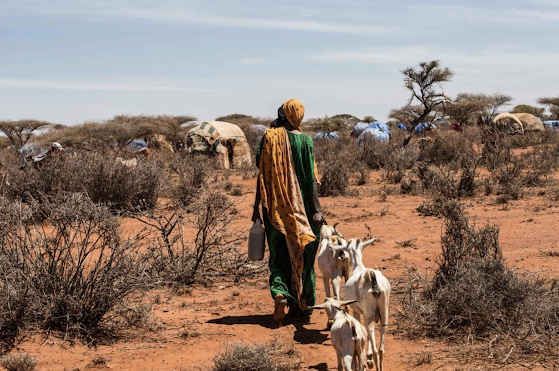Climate Change Impacts on Rural Domestic Water Supply
Over the last few weeks, we looked at how climate change can influence water resources in Africa with potential implications for human development. One of the main sources of water we mentioned that could be affected by climate variability is groundwater. Groundwater is the water stored in geological formation under the earth’s surface and is estimated to provide around 60% of rural populations in Africa with domestic water supplies through springs, wells and boreholes (Figure 1) (Groundwater Foundation 2020; Joint Monitoring Programme WHO/UNICEF 2008). These groundwater supplies are important, particularly in rural communities, as many villages lack access to piped water (MacDonald et al. 2009). Therefore, groundwater is advantageous as it can provide affordable clean water to rural communities, particularly in arid regions where surface water resources may be less reliable during periods of drought (The World Bank 2000). Hence, as climate change is expected to reduce surface flows in some regions of Africa, increasing groundwater usage during this time may be a useful adaption (MacDonald et al. 2011). Therefore, over the course of two weeks I am going to explore whether it would be viable to increase groundwater dependence in the face of global warming and the potential implications this may have on rural communities in Africa.
Figure 1. Borehole being used for rural community water supplies in Uganda, East Africa (Fields of Life 2020).
To determine the resilience of groundwater in Africa to climate change requires us firstly to understand the hydrogeological environment. The availability of groundwater and the processes of recharge are complex and depends largely on the interactions between the geology, weathering and climate (Taylor et al. 2009). Some of the main natural influences on processes of aquifer recharge in Africa are the El Niño-Southern Oscillation and the North Atlantic Oscillation which have been shown to cause inter-annual and multi-decadal changes in groundwater levels (Klove et al. 2014). This recharge often occurs through the infiltration of precipitation into the water table from soils or surface water leakage from streams and rivers (US Geological Survey 2020). However, as we discussed in our first post, under global warming we would expect changes in the intensity, duration and frequency of climatic and extreme weather events (IPCC 2012). In particular, climate change may cause longer periods of drought, potentially limiting the amount of water available for groundwater recharge (Famiglietti 2014).
However, many studies suggest that groundwater resources in Africa may have a natural resilience to climatic variability (Taylor et al. 2013; Cuthbert et al. 2019). For example, Taylor et al. (2013) has shown that groundwater recharge in the Makutapora Wellfield in Tanzania was driven by periods of intense seasonal precipitation (Figure 2). Under climate change, although we would expect longer periods of drought, we are also likely to see an increase in the frequency of extreme rainfall events (IPCC 2012). This means that groundwater recharge may still occur during global warming, suggesting that it could be a viable adaption to the reduction in surface waters that may occur in drought years.
Figure 2. The relationship between (a) groundwater levels; (b) monthly rainfall and (c) monthly groundwater abstraction in the Makutapora Wellfield, Tanzania (Taylor et al. 2013).
Furthermore, Lapworth et al. (2013) suggests that shallow groundwater resources (<50m) in Africa, which are most commonly used for domestic water supplies, are able to provide an effective buffer against reduced rainfall during periods of drought. The study showed that the mean residence time (MRT) of groundwater extracted from both sandstone and basement rock were similar across different climatic zones in West Africa (Figure 3). The MRT is the average amount of time the groundwater in the aquifer is expected to last under low volume pumping. The results could be explained in weathered basements by more effective recharge in arid regions compared to tropical zones due to less saturation of the surface rock and so lower runoff in the more arid regions (Figure 4). This suggests that despite lower rainfall, recharge could still occur in in arid areas. This means that even if the climate of Africa does get drier as predicted, this may not result in the widespread failure of groundwater resources.
Figure 4. The flow processes influencing groundwater recharge in basement aquifers in (a) humid and (b) arid environments (Lapworth et al. 2013).
Although this may seem like positive news for the future of groundwater supplies under climate change, we need to be cautious about the conclusions we draw from these studies. This is because even if the quantity of groundwater could be maintained during longer droughts, more intense precipitation events from global warming or land use change can lead to the contamination of shallow groundwaters (MacDonald et al. 2009). Furthermore, Lapworth et al.'s (2013) study may not be representative of the impact of global warming on all groundwater resources as they only sampled aquifers subject to low volume abstractions. However, as we will explore in the next post, the resilience of groundwater during climate change is not just a factor of the physical environment, but also influenced by demand side pressures which are likely to increase under warmer conditions (Famiglietti et al. 2011).






Great synthesis of resources. I would encourage you to write your argument/key point at the start to draw in readers and let them know what you are discussing and why it is important. You can then reflect on what you have covered at the end, as you have already done here.
ReplyDeleteI would also encourage you to write in the active voice to bring your argument out more.
Looking forward to reading the next posts!
(GEOG0036 PGTA)